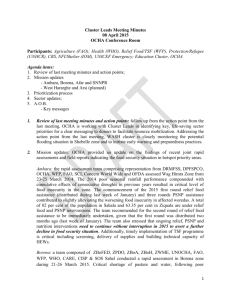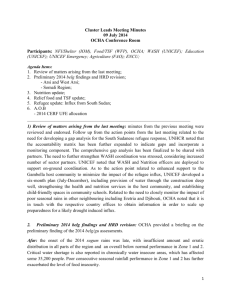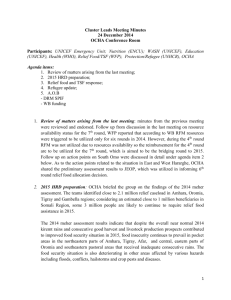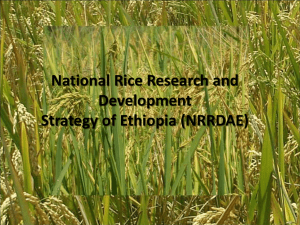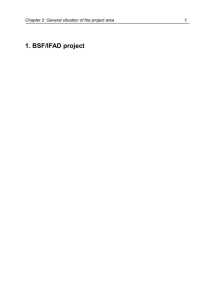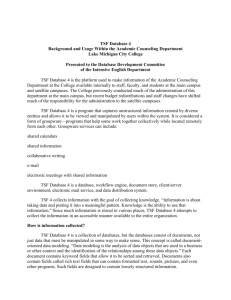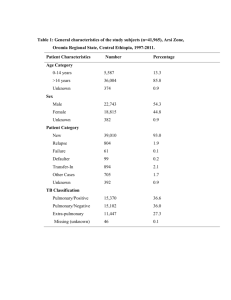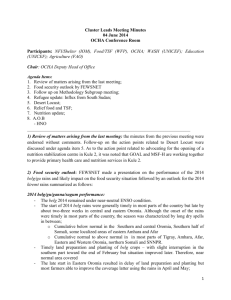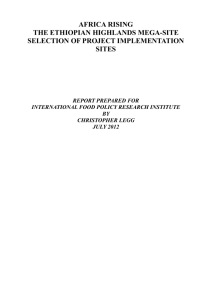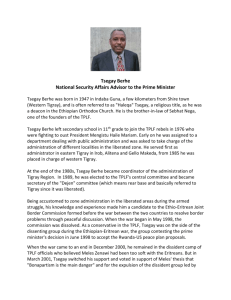Draft 130814 Cluster Leads Meeting_Minutes
advertisement
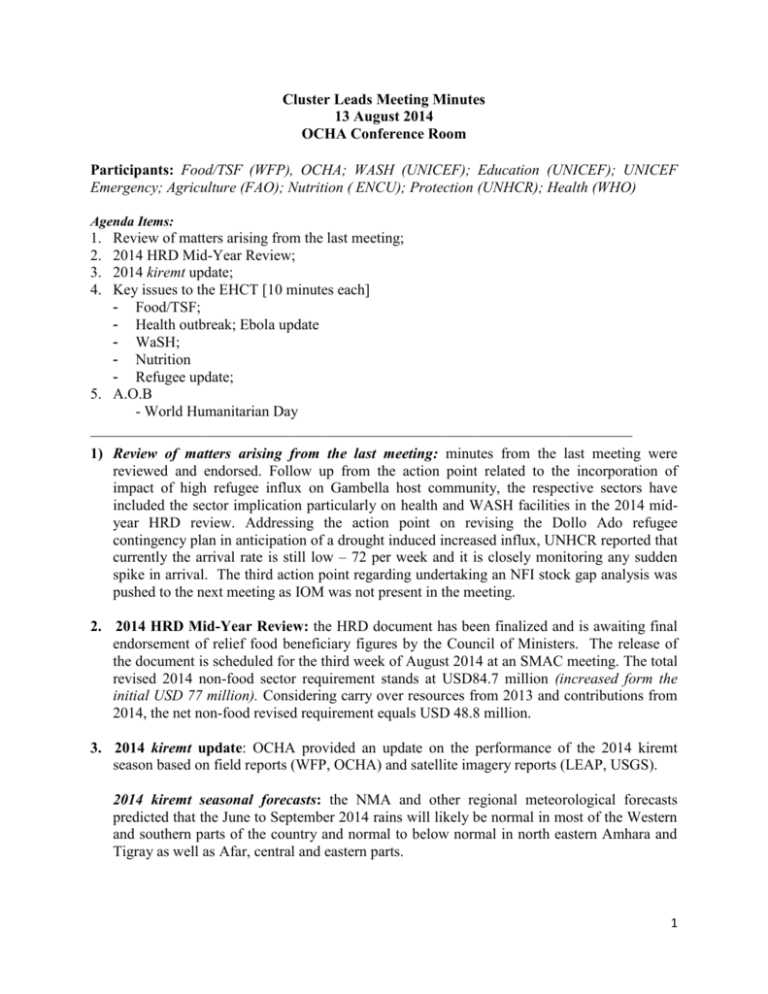
Cluster Leads Meeting Minutes 13 August 2014 OCHA Conference Room Participants: Food/TSF (WFP), OCHA; WASH (UNICEF); Education (UNICEF); UNICEF Emergency; Agriculture (FAO); Nutrition ( ENCU); Protection (UNHCR); Health (WHO) Agenda Items: 1. 2. 3. 4. Review of matters arising from the last meeting; 2014 HRD Mid-Year Review; 2014 kiremt update; Key issues to the EHCT [10 minutes each] - Food/TSF; - Health outbreak; Ebola update - WaSH; - Nutrition - Refugee update; 5. A.O.B - World Humanitarian Day ________________________________________________________________________ 1) Review of matters arising from the last meeting: minutes from the last meeting were reviewed and endorsed. Follow up from the action point related to the incorporation of impact of high refugee influx on Gambella host community, the respective sectors have included the sector implication particularly on health and WASH facilities in the 2014 midyear HRD review. Addressing the action point on revising the Dollo Ado refugee contingency plan in anticipation of a drought induced increased influx, UNHCR reported that currently the arrival rate is still low – 72 per week and it is closely monitoring any sudden spike in arrival. The third action point regarding undertaking an NFI stock gap analysis was pushed to the next meeting as IOM was not present in the meeting. 2. 2014 HRD Mid-Year Review: the HRD document has been finalized and is awaiting final endorsement of relief food beneficiary figures by the Council of Ministers. The release of the document is scheduled for the third week of August 2014 at an SMAC meeting. The total revised 2014 non-food sector requirement stands at USD84.7 million (increased form the initial USD 77 million). Considering carry over resources from 2013 and contributions from 2014, the net non-food revised requirement equals USD 48.8 million. 3. 2014 kiremt update: OCHA provided an update on the performance of the 2014 kiremt season based on field reports (WFP, OCHA) and satellite imagery reports (LEAP, USGS). 2014 kiremt seasonal forecasts: the NMA and other regional meteorological forecasts predicted that the June to September 2014 rains will likely be normal in most of the Western and southern parts of the country and normal to below normal in north eastern Amhara and Tigray as well as Afar, central and eastern parts. 1 2014 kiremt Actual performance: - The onset of the rains and overall performance has been normal in the western parts of the country including western Oromia, Amhara, Tigray, Beneshangul Gumuz and Gambella. The rains from last week of July tended to be above normal in most of these areas posing risks of flooding particularly in flood prone areas around Lake Tana in Amhara Region, central and western Oromia, northern half of SNNPR, western Tigray and Gambella region. NMA predicts the rains to continue with high intensity in the reminder of the season. LEAP products, however, indicate a decline in rainfall amount during the first ten days of August compared to last ten days of July. - Conversely, the onset of the rains delayed by 3 to 5 weeks in the eastern half of the country including in northeastern Amhara, eastern Tigray, Afar, central and eastern Oromia as well as many rift valley areas in SNNPR, with an overall below normal performance. The performance in most areas started to improve from the last ten days of July. The delayed onset and overall poor performance affected long-cycle crops and farmers in some areas opted to shift to short-cycle crops which have lower yields. Furthermore, if the forecast by NMA holds, the kirmet rains in the eastern half, mainly the northeastern areas, are expected to withdraw earlier than normal, which would have an adverse impact on the 2014 harvest prospects. - Poor performance of the kiremt rain coupled with belg failure is becoming big concern for the current food security situation in in Arsi, East and West Hararghes, Bale and West Arsi woredas.. In Most of these areas the amount of rain received so far is below normal as a result three woredas in each of East Hararghe, Bale, and Arsi water trucking is underway. Reports from East Hararghe, West Hararghe, Bale, Arsi and West Arsi shows relative improvement of the rain performance in mid and highland woredas starting from the last week of July, while the low land woredas have not received adequate rain until now. In East Hararghe significant increase in malnutrition is reported. - Unlike the NMA forecast, the onset of the meher rains was late by about 2-5 weeks in most places in SNNPR particularly in the lowland areas Sodo, Mareko and Meskan woredas of Gurage zone; Lanfuro, Sankua, Dalocha, Silite and Hulburge woredas of Silite zone; Duguna Fango, Damot Woyde and Humbo woredas of Wolayta zone; Mirab Abaya, Boreda, Kemba and Bonke woredas of Gamo Gofa zone; Boricha woreda of Sidama zone and in Halaba Special woreda. - The delayed onset and long dry spell in the month of June and the first three weeks of July negatively impacted planted long-cycle crops in the eastern parts of the country. During the last ten days of July and the first ten days of August, the ‘kiremt ‘rains improved in in most parts of the country. This rains have benefited both long (e.g. sorghum) and short (e.g. teff) maturing crops. On the other hand, some localized flooding was reported in Fogera, Raya Azebo and Alamata areas. 2 - Critical water shortage and worsening food insecurity continues to be reported in Zone 1, 2 and 3 of Afar region with reports of considerable drought induced livestock death particularly in Zone 3. Overflow of Awash river, on the other hand, caused flooding in areas of Gewane, Buremudaitu, Amibara and Awash Fentale woredas in Zone 3, affecting farmlands grazing grounds and washing away household assets including livestock.. Cluster leads underscored the need to scale up response efforts in Afar region. Despite the strong engagement of the region and request for assistance, limited partners’ presence has hindered comprehensive response, further deepening food insecurity and vulnerability. The need for Cluster Leads to closely liaise with sector actors to increase presence was underscored in the meeting. In the absence of partners on ground presence, the need for Cluster Lead agency to explore way for enhancing response was noted in the meeting. Action Point: 1) based on the seasonal update, OCHA to prepare a map of the kiremt 2014 forecast versus the actual situation to identify priority areas of concern; Action Point: 2) Cluster Lead agencies to closely liaise with sector actors to increase presence in Afar region; Action point 3) in the absence of partners on ground presence, Cluster Lead agency to explore way for enhancing response in Afar region; 4) Key issues to the EHCT [10 minutes each] - Food: Distribution of the 2nd round has reached 98 per cent. Dispatch and distribution of 3nd round stands at 99 per cent and 83 per cent respectively. Dispatch of the 4th round is also on progress and it is at 24 per cent. A total of 1,119,544 beneficiaries are assisted under RFF (risk financing food) modality in the 3rd round and the dispatch and distribution for this modality is 98 per cent and 78 per cent respectively. Action point: 3) WFP to follow up on the development of an elaborative reponse plan for the coming rounds including utilization of RFM; - TSF: TSF dispatch status for the May to August allocation stands at 99 per cent for Amhara, Afar, Oromia, Tigray and SNNPR regions. TSF has, however, not yet been dispatched to Somali region, awaiting EOS screening. Concerns were raised over the extended delay in undertaking EOS screening despite worsening food security situation and a deteriorating nutritional status. Action point: 4) UNICEF to liaise with the FMoH and Somali RBH to expedite the EOS screening in order to kick start TSF intervention; WFP reported that TSF is available to cover the current caseload and once the priority one woreda list is released, gap analysis will be done with the new woreda list. WFP is exploring ways to expedite TSF interventions and has proposed for the regions to undertake transport tender process with estimated figures rather than waiting for the actual figure. 3 - Health outbreak: Measles: In the first week of August, 160 suspected measles cases were reported nationwide, 50 per cent reported from Amhara and Oromia regions. Close to 69 per cent of the confirmed cases were children under-15. Yellow fever: reactive vaccination will be conducted between 18 to 22 August 2014 in South Omo, following the outbreak in 2014. Ebola: The current Ebola outbreak that has affected four Western African countries, continued to pose international health threat. Ethiopia, being a hub and a transit center, is at risk of the current outbreak, which is the largest in the history of Ebola. The Government, in collaboration with patterns, is scaling up prevention and preparedness measures. An Incident Command Post has been activated at the Airport to monitor the situation. The airlines staff were trained and provided protection equipment. A fever detector is installed to screen passengers coming from Nigeria as part of preventive measures. Ministerial and technical level meetings are regularly held at MoH to monitor the situation. - WaSH: At the heel of the drought, flooding poses WASH related risks in affected areas. UNICEF is pre-positioning water treatment chemicals in flood prone areas. Meanwhile, water shortage persist in drought affected pastoral areas in Afar and southeastern parts. Based on the HRF call for proposal for an allocation of USD 2 million for emergency WASH response, project proposals were received and are being reviewed by the sector. - Nutrition: The SAM admission in TFP services in June stands at 21,136 with 84 per cent reporting rate. With inclusion of more reports from Oromia, Somali and Tigray regions, the total caseload is expected to be closer to the HRD projection. Meanwhile, the hotspot revision is underway at federal level with inputs from the region; the number of priority one woredas is expected to nearly double from the current 76 woredas. Despite the growing humanitarian needs, the gloomy funding for the second half of 2014 raises a huge concern. The need to scale up response efforts in order to mobilize more resources was underscored in the meeting. Delays in the delivery of food aid were cited as amongst key drivers of malnutrition and the necessity of more expensive remedial commodities such as TSF and RUTF. - Refugee update: the total number of arrivals have reached over 183,000. The average arrival rate dropped from 882 to 637 during last week, mostly attributed to the rainy season. With continued clashes, the number is likely to pick once the rainy season is over. The Security Council will convene on South Sudan this week, which may bring some progression. UNHCR noted that those crossing the border with livestock tend to stay near the border. Action point:5) Cluster leads to share priority sector concerns to be shared with the EHCT ahead of the next meeting on 21 August 2014; 4 5. A.O.B - World Humanitarian Day: will be celebrated on Tuesday 19 August 2014. On the day, a Reception will be held with invited members of the humanitarian community, ambassadors, Government representatives and the media at the Africa hall (old ECA bldg., 1st floor). This year, the World Humanitarian Day celebrates humanitarian aid workers and commends their selfless service for humanity, often times in challenging and dangerous circumstances. To this end, two aid workers (one national staff from UNICEF and one international staff from GOAL Ethiopia) will deliver a speech on what it means to be a humanitarian aid worker. The Ethiopian Red Cross has organized a Humanitarian exhibition from 15 to 18 August and UNOCHA rented a booth at the exhibition center to display World Humanitarian Day materials and other publications collected from partners showcasing the work we do as humanitarian agencies. Protection cluster: UNHCR requested for the inclusion of protection cluster update in the Cluster Leads meetings; 5

